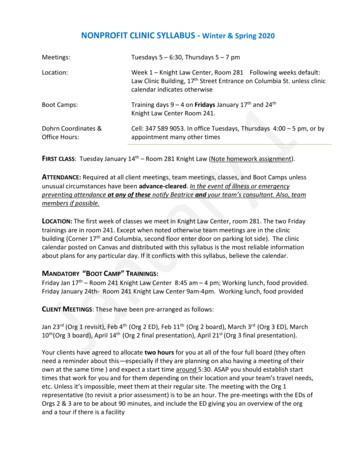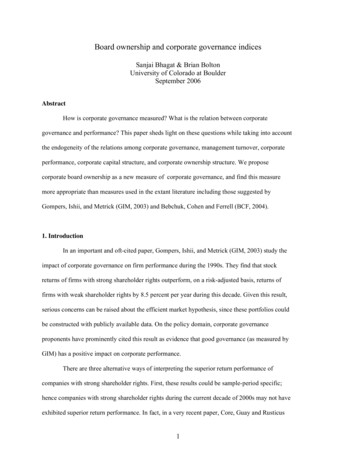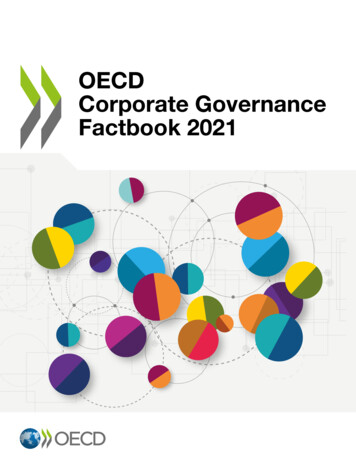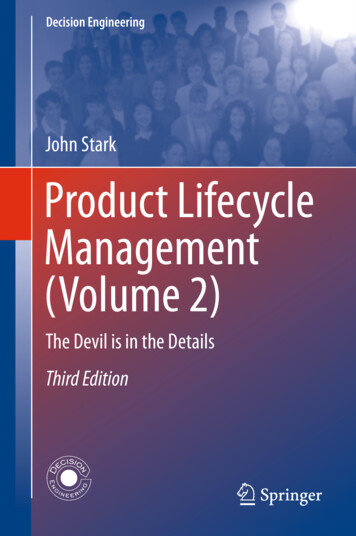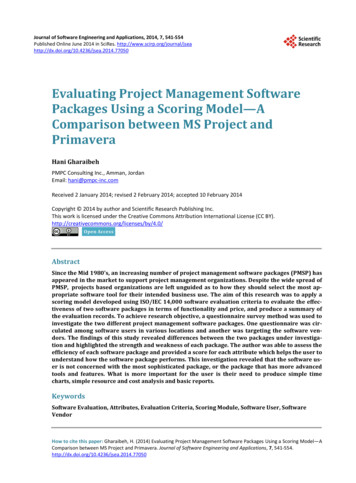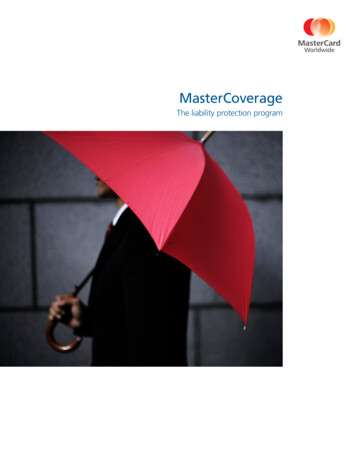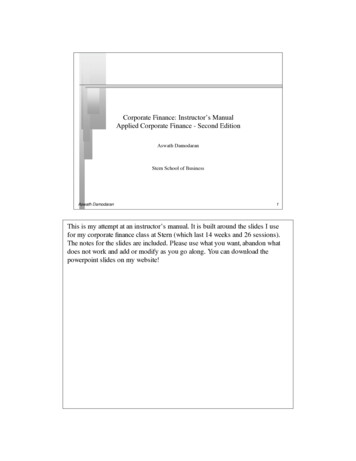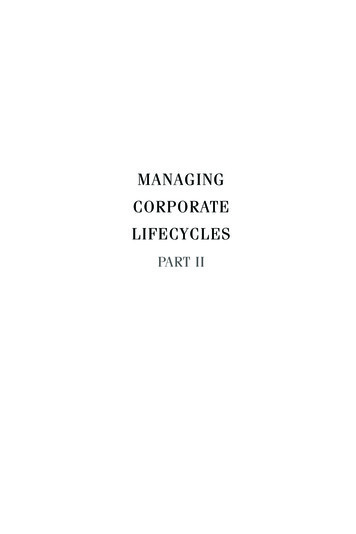
Transcription
1managingcorporatelifecyclesPART II
2M a n ag i n g C o r p o r at e L i f e cyc l e sBOOKS BY THE AUTHOR1. Adizes, I. Industrial Democracy: Yugoslav Style. New York Free Press, 1971.2. Adizes, I. and E. Mann-Borgese, eds. Self-Management: New Dimensions to Democracy.Santa Barbara, CA: ABC-CLIO, 1975.3. Adizes, I. How to Solve the Mismanagement Crisis. Homewood, IL: Dow Jones/ Irwin,1979.4. Adizes, I. Mastering Change: The Power of Mutual Trust and Respect in Personal Life,Family Life, Business & Society. Santa Monica, CA: Adizes Institute, 1991.5. Adizes, I. Managing Corporate Lifecycles: An updated and expanded look at theCorporate Lifecycles. First edition. First printing, Paramus, NJ: Prentice Hall Press, 1999.Additional printings by the Adizes Institute Publications.6. Adizes, I. Pursuit of Prime. First printing Santa Monica, CA: Knowledge Exchange,1996. Additional printings by the Adizes Institute Publications.7. Adizes, I. The Ideal Executive: Why You Cannot Be One and What to Do About It. SantaBarbara, CA: The Adizes Institute Publications, 2004.8. Adizes, I. Management/Mismanagement Styles: How to Identify a Style and What to DoAbout It. Santa Barbara, CA: The Adizes Institute Publications, 2004.9. Adizes, I. Leading the Leaders: How to Enrich Your Style of Management and HandlePeople Whose Style Is Different from Yours. Santa Barbara, CA: The Adizes InstitutePublications, 2004.10. Adizes, I. How to Manage in Times of Crisis (And How to Avoid a Crisis in the FirstPlace). Santa Barbara, CA: The Adizes Institute Publications, 2009.11. Adizes, I. Insights on Management. Santa Barbara, CA: The Adizes Institute Publications,2011.12. Adizes, I. Insights on Policy. Santa Barbara, CA: The Adizes Institute Publications, 2011.13. Adizes, I. Insights on Personal Growth. Santa Barbara, CA: The Adizes InstitutePublications, 2011.14. Adizes, I. Managing Corporate Lifecycles—How Organizations Grow, Age and Die,Volume 1. Second edition. Santa Barbara, CA: The Adizes Institute Publications, inconjunction with Embassy Book Distributors, 2012.15. Adizes, I. Food for Thought: On Management. Santa Barbara, CA: The Adizes InstitutePublications, 2013.1 6. Adizes, I. Food for Thought: On Change and Leadership. Santa Barbara, CA: The AdizesInstitute Publications, 2013.17. Adizes, I. Food for Thought: On What Counts in Life. Santa Barbara, CA: The AdizesInstitute Publications, 2013.18. Adizes, I. Insights on Management – II. Santa Barbara, CA: The Adizes InstitutePublications, 2014.19. Adizes, I. Insights on Policy – II. Santa Barbara, CA: The Adizes Institute Publications,2014.20. Adizes, I. Insights on Personal Growth – II. Santa Barbara, CA: The Adizes InstitutePublications, 2014.21. Adizes, I. Conversations with CEOs. Santa Barbara, CA: The Adizes InstitutePublications, 2015.22. Adizes, I. Managing Corporate Lifeycles—Analyzing Organizational Behavior andRaising Healthy Organizations, Volume 2. Second edition. Santa Barbara, CA: TheAdizes Institute Publications, 2015.
3MANAGINGCORPORATELIFECYCLESPART IIIchak Kalderon AdizesFounder and CEO, Adizes InstituteSanta Barbara County, California
Library of Congress Cataloging-in-Publication DataAdizes, Ichak.Managing Corporate LifecyclesCopyright 2015 Dr. Ichak AdizesAll rights reserved. No part of this publication may be reproduced in any form, by anymeans (including electronic, photocopying, recording or otherwise), without permissionof the author and the publisher.Library of Congress Control Number PendingISBN: 978-0-937120-25-5Published by Adizes Institute Publications1212 Mark AvenueCarpinteria, Santa Barbara County, California, USA 93013805-565-2901; Fax 805-565-0741Website: www.adizes.comText design and layout by Dana Levy, Perpetua PressPrinted in the United States of AmericaAdditional copies may be ordered from www.adizes.com/store
To my clientswithout whomall my work would be in vain.
6M a n ag i n g C o r p o r at e L i f e cyc l e s
7ContentsIntroduction9Part I: Analyzing Organizational BehaviorChapter One: The Origins15Chapter Two: Predicting the Lifecycle: A Metaphorical Dance 45Chapter Three: (PAEI) and the Lifecycle: Stage by Stage61Chapter Four: Predicting the Capability to Solve Problems 85Chapter Five: The Causes of Organizational Aging105Chapter Six: Structural Causes of Aging131Part II: Raising Healthy OrganizationsChapter Seven: Organizational Therapy155Chapter Eight: Treating Organizations on the Typical Path:A Contingency Approach169Chapter Nine: The Optimal Path199Summary223
8M a n ag i n g C o r p o r at e L i f e cyc l e sPart III: AppendicesAppendix A: Case Studies227Appendix B: Explorations of Some Eternal Questions249
9IntroductionTHIS BOOK IS THE SECOND PART of a two-volume work inwhich I present the theory of organizational lifecycles and theprinciples for leading organizational change that I have practicedand refined over the last forty years.The first book, Managing Corporate Lifecycles: How OrganizationsGrow, Age, and Die, Volume I1 describes the typical behavior oforganizations on the path from startup to bureaucracy, and evenorganizational death. In it, I highlight the normal and abnormalproblems organizations encounter on this lifecycle. Volume I wasdescriptive.In this second book, Volume II, I provide the diagnosis, the toolsto explain why organizations grow and die, and introduce whatinterventions are necessary to bring an organization to Prime. Thedetailed prescriptions are in my book Pursuit of Prime.2We’ll consider what causes organizations to develop and subsequentlyto age, what causes flexibility and self-control, and why organizations have the problems described in Managing Corporate Lifecycles:How Organizations Grow, Age, and Die, Volume I.I will present a postulate to explain organizational behavior.I postulate that all living systems—and every organization is a livingsystem—seek to be effective and efficient in the short and the longrun.3 It is as if the organization knows what it is doing. It is as ifconscious forces guide organizations. Human leaders play their roles;4The players can speed the plot by turning the pages faster; they caneven skip pages if they can find the shortcuts.
10M a n ag i n g C o r p o r at e L i f e cyc l e sIn organizations, what causes behavior is the system’s drive for effectiveness and efficiency in the short and the long run. An organizationis in Prime when it is both effective and efficient in the short and longrun. Organizations seem to drive to Prime, and management, if performed correctly, is the process that facilitates getting there. If, however, management is performed badly, it inhibits, retards, and evenblocks this innate tendency to progress to Prime. I once heard thatchildren are born capable of perfection.5 We the parents can eitherhelp the process of its realization or mess it up. We need to knowhow and when to get out of the way. Similarly, our bodies want todevelop and be healthy. They tell us what they want, and each of uscould be healthier if only we listened and followed the instructionsour bodies give us. The same seems to apply to organizations.Don’t, for one minute, think that I am saying that there is no placefor leadership or that we humans are mere puppets in a show wehad nothing to do with writing. Not at all. Knowledge of medicalscience allows us to help or undermine the medical “reasons” fora healthy body. The same holds true for organizations. The role ofmanagement is to provide leadership and keep the organization inthe healthy part of the lifecycle, preventing or treating abnormal orpathological problems along the way. The role of leadership is tolead the organization to its Prime and sustain it there. For that reason, leaders and those who have chosen the consulting professionneed to understand what makes an organization healthy and whatmakes it sick. They must understand why organizations move alongthe lifecycle and why they develop normal, abnormal, or pathological problems. They have to know not only how to diagnose problems but also how and when to solve them.In this book, I present the theory that I have been developing now forover forty years to explain organizational behavior and to providethe tools for changing that behavior. Those are the tools for directing organizational culture away from abnormal problems, gettingthe organization on the typical path, moving it toward Prime, andsustaining its position there. As you will see in subsequent chapters,this theory has been tested to produce predictable results by thepractitioners of the methodology in over fifteen countries.
I n t ro du c t i o n11Once we understand the movement on the typical path, we willdiscuss how to get to and advance on the optimal path. (See Chapter9, The Optimal Path.)Notes1. Adizes, I., Managing Corporate Lifecycles: How Organizations Grow, Age, and Die, Volume I (SantaBarbara, CA: The Adizes Institute Publications in conjunction with Embassy Book Distributors, 2012).2. Adizes, I. Pursuit of Prime. (Santa Barbara, CA: The Adizes Institute Publications, 1996).3. See the research on autopoiesis processes, particularly H. Maturanaand F. Varela’s Autopoiesis andCognition (1980), and The Tree of Knowledge: The Biological Roots of Human Understanding (1987).See also the discussion of self-regulation that is circulating in the com plexity literature, particularly F Capra’sThe Web of Life: A New Understanding of Living Systems (New York: Doubleday Anchor, 1996), esp. Chapter4, “Models of Self-Organization.” This line of research has shown that systems reproduce themselves,selecting for their own survival; that is, evolution occurs with directionality. G. Bateson has called this process“orthogenesis” and notes that this process is the “outward and visible sign of interactive process” [G. Bateson,“From Anthropology to Epistemology,” in R. Donaldson, ed., Sacred Unity: Further Steps to an Ecology ofMind (New York: Harper, 1991)]. He was referring to the interaction between the com ponent parts of thesystem, and its environment. So the directional “choices” that a system makes as it self-regulates are a functionof the local and specific conditions which provide the information for the “choice.”4. One of the central mistakes of organizational theory has been the embedded assumptions about intention andrational “choice” that are attributed to organizational processes. See the critique of this posi tivist paradigm inD. Polkinghorne, Narrative Knowing and the Human Sciences, SUNY Series in the Philosophy of the SocialSciences (Albany: State University of New York Press, 1988), as well as J. Hassard, “Exploring the Terrain ofModernism and Postmodernism in Organizational Theory,” in D. Boje (ed.) et al., Postmodern Managementand Organization Theory (New York: Sage, 1996): 45–60.5. See J. Hiliman, The Soul’s Code: In Search of Character and Calling (New York: Warner, 1997), whichposits that each one of us has the capacity to realize our potential, just as an acorn will inevitably grow into anoak tree. Problems, he argues, are a function of the inability to unfold ourselves into our potential; it follows thatif we have a context to support “unfolding,” health and self-actualization follow.
12M a n ag i n g C o r p o r at e L i f e cyc l e s
13PA RT I AnalyzingOrganizationalBehavior
14M a n ag i n g C o r p o r at e L i f e cyc l e s
15Chapter OneThe OriginsSOME FORTY YEARS AGO, I discovered that for an organization to be effective and efficient in both the short and long run,four manager ial roles must be performed. I made that discoveryin the course of preparing my doctoral dissertation. I was studyingthe Yugoslav sys tem of self-management.1 To Western minds and experience, that system seemed alien. Nobody owned capital. Capitalwas the heritage of society. The Yugoslavs called it social ownership. That doesn’t mean government ownership. The ownership ofcapital was analogous to the ownership of air. The entire society hadaccess to capital but was not allowed to deplete it. Thus, organizational profits before depreciation had—at the very least—to equaldepreciation. Rather than salaries, people received allowances basedon a system similar to surplus sharing among the partners of a lawfirm. Employees elected representatives to the workers council, and thecouncil interviewed candidates for the job of managing director. Allthe candidates presented plans of what, if elected, they intended to dofor and with the company. The elected managing director’s term wasfour years long, but managing directors were subject to impeachmentif they acted illegally, say, acting without the autho rization of theworkers council. Sound familiar?Yugoslavs applied political democracy to their industrial and nonindustrial organizations, and they called that system industrial democracy. The system’s weakness was that it discouraged—actuallydestroyed—the entrepreneurial spirit. Entrepreneurs are individual istic, and few enterprises were able to find managing directors whoknew how to take risks under these circumstances.For all practical purposes, the entrepreneurial spirit was legally
16M a n ag i n g C o r p o r at e L i f e cyc l e sprohibited. The system mandated group entrepreneurship or bust.And bust it went. The goal was to create a New Human, whose moti vations, according to Karl Marx, would be very different from thoseof “Old Humans” plagued with exclusive materialistic motivations.2Anyway, the situation proved lucky for me. I was like that Britishdoctor who found himself on a ship with no available sources ofvitamin C. When he saw that the sailors, long deprived of vitaminC, suffered from scurvy, the doctor recognized the connection between vitamin deficiency and a predictable disease. Observing organizational behavior in Yugoslavia, I discovered that if a certainrole of management, say, entrepreneurship, is suppressed, organiza tions develop certain predictable managerial “diseases.” My bookHow to Solve the Mismanagement Crisis3 describes the styles of mis management that develop when one or more roles are deficient in anorganization. The point is that I discovered a diagnostic and thera peutic methodology. Because I could see the relationship betweeneach role and specific kinds of organizational behavior, I was able toidentify which role deficiency causes which managerial “diseases.”Input OutputManagement RoleMakes the organization:Time range(P)urposeful effective short run(A)dministrativeefficient short run(E)ntrepreneurialeffective long run(I)ntegrative efficient long runUsing the above model I learned to analyze and diagnose orga nizational problems. Noting that a company was slow to react tochange, I suspected deficiency of the (E), entrepreneurial, role. Onthe other hand, I suspected inadequacies in the (A), administrative,role if a company routinely delivered late, lacked cost controls, orfailed to document its engineering approval processes properly. Ithen dis covered that if it were possible for me to “inject” the missingroles, the organization would become effective and efficient in theshort run and the long run. And we did so, for instance, taking onecom pany from 12 million in revenues to 700 mil lion in revenues
Th e O r i g i n s17without any dilution in ownership. (Today the company’s revenuesare 1.5 billion.)Because no organization is “born” in Prime, each one has to develop those roles. As organizations develop the management rolesone by one, they follow the typical lifecycle curve, experiencing theproblems associated with deficiencies in one or more of those roles.When an organization gets “stuck” and is incapable of developinga particular management role, it experiences abnormal problems. Ifthe development delay is prolonged, the organization’s lack of thatmanagement role may threaten its ability to survive.Since organizations develop the four management roles in a predictable sequence, the problems are also predictable, and so is the therapy.The Four Management RolesLet us now investigate with some depth what those roles are. Thosefour necessary roles explain the development of organizational cul tures, and in particular, the why, when, and how of change in thelifecycle.The (P) RoleLeadership’s first function is the (P) role, which makes the organiza tion effective in the short run. The (P) stands for the organization’s(P)urposeful (P)erformance. What is the (P)urpose that must be(P)erformed? Is it profit?Imagine five people are walking down a narrow path along the topof a mountain. The path is so narrow, they must walk single file. Totheir right, there is a deep canyon, and to their left, there is a steepincline. They have been walking for hours, singing, joking, laughing,whistling, and talking. In the eyes of an organizational behaviorist,anthropologist, psychologist, or social psychologist, the five peopleare interacting as an organization.From a management point of view, although we can see that thefive have formed a socially interactive organization, we recognize nomanagerial process until the group encounters a rock so large that itblocks passage and none of the five can move it alone. At that moment, the managerial process begins. Someone needs to plan, organize,
18M a n ag i n g C o r p o r at e L i f e cyc l e smotivate, and control (or correct) actions that will allow the group tomove the rock. That someone does not necessarily have to be an individual. It can be a team making those decisions. Nevertheless, decisions have to be made that will move the rock: There are processesthat need to be performed for a goal to be iden tified and achieved.The managerial process exists when there is a task tobe performed, a task that requires interdependenceamong people.If a single person could lift the rock, there would be no man agerialcomponent to the group’s organization. If the same five peo ple werewalking along the path with a purpose—say, rock climbing or spelunking—that required interdependence, the management processwould have started even before they encountered the rock. What ifthe group simply went to have fun with no explicit plan? So long asthere is a purpose, the group needs a managerial process. It needsto articulate, operationalize, and re-articulate that purpose as needsdevelop. Unless the purpose is to have no purpose, purposes are notrealized by themselves. (Come to think of it, it takes effort not tohave a purpose too. In Zen Buddhism, they say it takes a tremendouseffort not to think!)The first role of management is to define or enable a definition oforganizational purpose. What is the function for which the orga nization exists?Every organization must have a reason to exist. Thatreason, that “rock,” is the focus of interdependencyamong people.Whenever I work with an organization I ask the top managers, “Whyare you together? What does accounting have to do with mar keting,or personnel with research and development? What’s the purpose ofyour organization’s existence?” I’m amazed how fre quently they tellme that the purpose of their organization is to make profits. That’sthe wrong answer. I gave this same answer in inter preting the (P) rolein How to Solve the Mismanagement Crisis.4Economic theory teaches us that the purpose of economic enti ties—of commerce—is profit. Who dares to argue? However, many or-
Th e O r i g i n s19ganizations are so preoccupied with profits that they go bankrupt.Why? If a company focuses on profits, shouldn’t it generate profits?No. That reasoning confuses input with output.Profit is like love, health, and happiness. If you focus on happi nessand say “I must be happy today,” you may become quite miserable. Ifyou say “I must be healthy,” you may become a hypochondriac. Andto say “There must be love” can create a great deal of hate. Whatyou must ask yourself is what makes you happy, healthy, or feel thatyou are in love. That should be your focus. Focus on the inputs inthe direction of the output. If you focus on the out put and ignore theinput, you create expectations that might not be realizable.If you were playing tennis, the scoreboard would be the profits. Whocan play successfully if his eyes are always on the scoreboard? Youshould ignore the board and play the best you can. Follow the ball,and hit it across the net to the opponent’s court. Organizations thatfocus on earnings per share and profit margins, rather than the inputand throughput that produce the profit, might be going bank rupt,not in spite of, but because of all their focus on profit. They are failing to keep their eyes on the ball.If you hit the ball effectively—repeatedly and efficiently (for which theother three roles are also necessary)—you will win the tennis game.Winning means you will be profitable. What then is the purpose of abusiness organization? What is the “rock” it must move? What is the“ball” it must watch? What (P)urpose should the organization(P)erform?Let’s think about the very earliest stages of Courtship, when foundersare dreaming about starting their organizations. What do they seein the future? Profits? That’s possible, but that’s not what gets themout of bed in the morning. They see opportunities to make profits.Note my choice of words: opportunities to make profits. Profit is anoutput; opportunity is the input. We have to focus on the input if wewant the output to occur. We have to hit the ball, exploit the opportunity, and treat every volley as a first volley.What are the opportunities that founders notice? They perceive unsatisfied needs in the marketplace, needs that they believe they cantruly satisfy.From a managerial point of view, the distinction between for-prof it
20M a n ag i n g C o r p o r at e L i f e cyc l e sand nonprofit organizations is no longer valid. Both organizationshave clients and both organizations, to be effective, must satisfy clients’ needs. The end results for the two are different: economic profitfor one and political or social survival for the other. But in bothcases, input management must have the same focus: to (P)erform aservice, and to satisfy the needs of the clients for which the organization exists. That is, both must aim to add value.Every organization—whether it’s a unit within a larger organi zationor the large organization itself—has clients for which it exists. Thereis no organization and no management without clients. The clientsof the sales organization are called customers, and the accountingdepartment and the personnel department have only clients, not customers. Their clients are within the organization.By definition, each organization has a reason to be: to satisfy clients’needs that cannot be satisfied by an individual.If an organization does not focus on its clients’ needs, it behaves likea cancer: It exists and consumes resources, but it serves no clientfunctions. It serves only itself.When a manager makes a decision, he must first ask himself whatthe (P) role is. Who are his organization’s clients? What are theirneeds? Which needs can, and will, the organization satisfy? That isthe (P)urpose of the organization he manages. This applies not justto top management, but to managers at every level.If the organization performs the (P) function, it will be effectivebecause it satisfies the needs for which it exists. We measure effec tiveness in terms of repetitive demands for the organization’s ser vices.In business, that is called brand loyalty. Do the clients come backfor more? If they don’t come back for more of the same service orproduct, it means their needs are not being satisfied, and the orga nization is not effective.Profit, as I have stated, is the indicator of how well the organi zationperforms all four management roles. That is, it indicates how effectiveand efficient the organization is in the short and the long run.Organizational effectiveness indicates performance of the pur posefor which the organization was created. A pen is effective if it writes.What if the pen doesn’t write but you can use it to scratch yourhead? If it was designed for head scratching, it would not be called
Th e O r i g i n s21“pen,” it would have been called “head scratcher.” How about achair? It is a chair if you can sit on it. Why don’t you call it a cow?You should, if you can milk it. “I can sit on a cow, so why don’t I callit a chair?” a student once asked me. “Because a cow has not beencreated for sitting.”I am postulating again that everything, absolutely everything, is created with a purpose. The light is for illumination; the heater is toprovide heat; and so forth. The same is true for us as people. Someof us are created to write. We nevertheless spend our lives scratching our heads. When you do that for which you have been created,you feel fulfilled. When I present my material in lectures that lastsix hours, even after a long flight from home through several timezones, I feel rejuvenated. I end up with more energy than when Istarted. But if you want me to do bookkeeping, I’ll beg you to shootme first!I have no doubt that my accountant would ask for the firing squadif he had to present a lecture.But not only chairs, cows, and people like me and you have a purpose. Organizations also have purposes. They should follow theircalling and stop scratching their heads if they were designed towrite. Just as I can’t do bookkeeping, some organizations cannotand should not conduct basic research. They know how to commercialize technology. They cannot develop it. Some companies are excellent retailers, but do not ask them to create high fashion. Even ifthey hired creative designers, the designers would never survive thepenny pinching that prevails in the retailing culture with its bonethin margins.In today’s business lingo, people talk about core competencies. Organizations should stick to them, but corecompetencies are not just know-how and equip ment. Theyinclude the organizational culture as well.Years ago I studied performing arts organizations. (I estab lished thefirst Master’s program in the world in Management of the Arts atUCLA in 1969.) In the process of my research, I visited the Minneapolis Symphony, which is now the Minnesota Orchestra. At thetime, Stanislaw Skrowaczewski was the artistic director and con ductor.
22M a n ag i n g C o r p o r at e L i f e cyc l e sThe symphony’s board of directors was debating whether or not toinaugurate a summer season of pops in the park, similar to the Boston Symphony’s Boston Pops. Skrowaczewski was adamant ly opposed. “You cannot,” he said, “take a musician who plays Paganiniduring the winter season, ask him to play Sousa in the sum mer, andat the end of the summer tell him to play a Mendelssohn concerto.”In my business language, he was saying, “You cannot pro duce aRolls-Royce and a Yugo using the same labor force.” Yugo producers don’t have Rolls-Royce’s compulsive dedication to quali ty. Thattakes years to develop and make an integral part of the cul ture. Twoproduct lines are fine. Boston offers two distinct product lines, andthere are two orchestras: one plays pops and the other is the symphony orchestra. The concert master and other leading musi ciansplay chamber music during the summer, while the others play popsin the park.In other words, every organization must decide who it is and what itdoes. It cannot be whatever makes money at that minute. You shouldnot try to milk a chair even if the price of milk is sky rocketing.How does an organization identify its (P) role?Rabbi Hillel, in the Wisdom of the Fathers, asks, “If I am not formyself, who is for me? And when I am for myself, what am I?” AsI have said, everything has a purpose, and that is to serve others.The lamp is here to shine light so I can type. The food I just ate isto nour ish me. The bed across the room is for me to rest and sleepupon. Nothing in life exists for itself. Anything that serves only itselfis like a cancer which serves no function but death. Some people arecancer ous. Existing for no one but themselves, they are exclusivetakers. They take more from the land, water, and people than theyleave behind. They destroy social value. They are socially cancerous.Sustainable growth is not an empty slogan.To be functional—that is, effective—an organization must, from theoutset, define for whom it exists, who are its clients, and which oftheir needs will the organization satisfy. No organization can orshould be everything for everyone. Segment your market. Next, goand do it. That means: (P)rovide the desired needs of your clients;(P)roduce the results to which you are committed; (P)erform asexpected.
Th e O r i g i n s23That is the (P) role that, if (P)erformed, causes organizations to produce the results for which they exist.The (A) RoleHow about efficiency in the short run?To be efficient in the short run, management must systematize, program, and organize. It must see to it that the right things happen atthe right time, with the right intensity, in the right sequence. Thatmeans (A)dministration. For that, management needs to think linear ly, logically, and with attention to details. Proper (A)dministrationpre vents an organization from reinventing the wheel every time itneeds to wheel something around.The (P) and (A) roles can create effectiveness and efficiency in theshort run. With only those two management roles, the organizationwill be profitable in the short run.The (E) RoleImagination is more important than knowledge.ALBERT EINSTEINWhat do we need for long-term effectiveness?Again, let’s consider the tennis example. Hitting the ball over thenet into the opponent’s end is the (P) role. The volley was effec tive.We (P)erformed the (P)urpose for which we hit the ball. In trainingto play tennis, practicing and perfecting motion to utilize minimumenergy for maximum impact, we provide for the (A) role, making ourgame efficient.But winning a volley is not winning the game. To win a game youmust do more than win a
Additional printings by the Adizes Institute Publications. 6. Adizes, I. Pursuit of Prime. First printing Santa Monica, CA: Knowledge Exchange, 1996. Additional printings by the Adizes Institute Publications. 7. Adizes, I. The Ideal Executive: Why You Cannot Be One and What to Do About It. Santa Barbara, CA: The Adizes Institute Publications .

